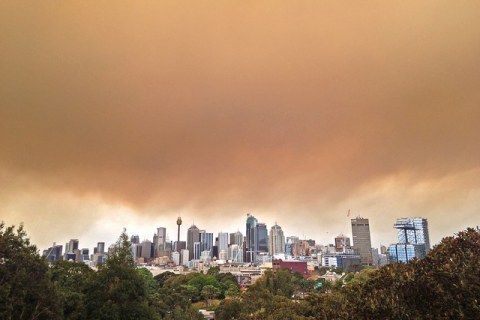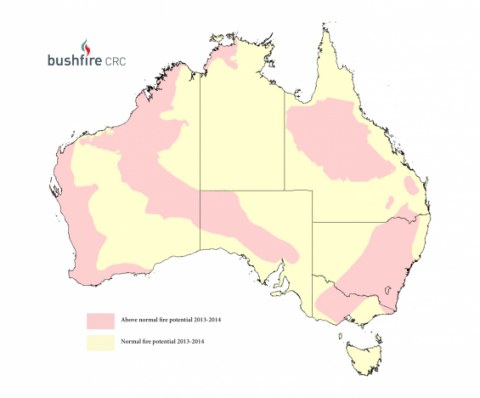Widespread October bushfires in NSW are unusual, but have happened before, such as in 1991. This year there was an Early start to Australian bushfires, record temperatures in early September.
It is now the 7th time this bushfire season a total fire ban has been declared in Sydney. Very Unusual. If the fire weather is this bad so early in the season, it can get worse over the coming months as Summer heats up, especially if we have extreme summer heatwaves similar to 2013.
Update: Sunday 20 October: Premier Barrie O'Farrell has declared A State of Emergency across NSW for 30 days as weather conditions are now forecast to be worse than anticipated. Indefinite Total fire bans, and increased powers for emergency personnel. The State Mine fire in the Blue Mountains has burnt 38,000 hectares and is burning on a broad front from Lithgow to west of Bilpin.
These bushfires today are worse than 1991, the last time a significant fire emergency occurred in mid October and rival the 1968 bushfires which
Here is a comparison of the present event to the 1991 bushfire season taken from the Brief History of Bush Fires in NSW on the NSW Rural Fire Service website. Fire emergencies of this magnitude have been seen before, but usually in December or January, like the 1994 Eastern Seabord fires that started on 27 December 1993 and lasted to 16 January. You need to go back to 1991 to find one comparable in mid October.
- 16 Oct 1991: 30 blazes, 14 homes lost, 2 deaths.
- 17 Oct 2013 9.15pm: 98 fires burning, 34 of them uncontained, and seven at emergency warning level, perhaps 100s homes lost. No deaths so far reported...
Professor Ross Bradstock, Director of the Centre for Environmental Risk Management of Bushfires, said they were comparable with the fires in November 1968, “On average there has been one destructive fire a decade in the Blue Mountains, but these appear to be the most destructive fires since 1968, when over 100 houses were also lost in the same area. We are in a very dry situation in the greater Sydney region and when these landscapes dry severely, many of the natural barriers to fire are removed. In these sorts of dry conditions fires can burn for weeks until there is a significant change in the weather.”
David Jones, head of climate analysis at the Bureau of Meteorology said in an interview in the Sydney Morning Herald that will see fire conditions worsen for much of Australia over the longer run:
"While weather patterns vary from year to year, southern Australia is already seeing springs and summer becoming hotter. As a result, there is a "trend towards more severe fire weather conditions across Australia.”
"We know from about March-April to around June, things have been drying out across southern Australia," he said.
"The fact there is less soil moisture increases the fire risk both towards the end of the fire season but also the subsequent fire season," Dr Jones said. "You have a lesser opportunity to really wet up the vegetation.”
“Global warming exacerbates a number of factors associated with fire," he said, adding that humidity is expected to decline over much of the continent particular in summer.

Southern Australia Seasonal bushfire outlook 2013/2014 published by the Bushfire CRC
Justin Leonard, CSIRO’s research leader for Bushfire urban design, said “House loss is highly likely under these conditions, life loss is also likely. History has shown us that on average one life is lost for every 17 houses. The majority of these lives are lost within a few hundred metres of homes. When fires are near, use the home as a refuge rather than fleeing at the last minute. Monitor the home’s condition while you shelter in case you need to exit the house on to burnt ground.”
Here is the media conference this afternoon with NSW Premier Barrie O'Farrell and NSW RFS Commissioner Fitzsimmons.
"This is as bad as it gets," said NSW RFS Commissioner Shane Fitzsimmons, at the media conference on Thursday afternoon with NSW Premier Barrie O'Farrell, “It’s going to be a long dangerous and difficult evening ahead for firefighters and obviously the communities in the path of these fires," he said. "Some areas will take weeks of firefighting and containment particularly given “the most difficult and arduous terrain that these fires have traversed across.”
The bushfires in the Blue Mountains will be particularly hard to extinguish in the rugged valleys, and may take several weeks.
Although the exact numbers of property and houses burnt isn't known at this stage, O'Farrell made it clear it was likely to be in the hundreds. The Hume Highway has been cut for a number of hours in the Southern Highlands, the Pacific Highway at Doyalson has also been disrupted south of Newcastle. Fires are raging from the Shoalhaven coast up to the north coast of NSW.
Both the Sydney Morning Herald and the Guardian had live blog pages covering the bushfires on 17 October.
David Bowman, Professor of Environmental Change Biology at The University of Tasmania, emphasised that the Australian community must understand better the very rapid evolution of bushfire disasters and plan accordingly:
"To my mind a significant feature of the NSW fires are the short time a hint of troubled spiraled into serious trouble all within 24 hours. A key factor is high wind speeds and hot conditions - again difficult to predict accurately - that drive fires and quickly dry fuels out.I am of course worried about the significance of the early start of the NSW fire season for southern Australia. In must be understood more widely that predicting fires’ start, duration and intensity of fire seasons is beyond our current scientific capacities.
I see the burst of fires in NSW (on the back of some extremely severe fires last year) as a very worrying sign for Tasmania, a community still recovering from the extreme January 4 fires."
We have just endured our hottest September on record, unusually warm winter, and the hottest 12 month period on record. All this is occurring with El Nino/ENSO cycle being neutral.
Fire weather is escalating and one of the factors driving this is long term climate change driving increasing temperatures, drier conditions with reduced soil moisture, and a lengthening of the fire season.
The science is clear that there is a long term trend for increasing fire weather risk, particularly in the elongation of fire seasons in Spring and Autumn. A study by Clarke and Lucas (2012) on Changes in Australian fire weather between 1973 and 2010 says: "These trends suggest increased fire weather conditions at many locations across Australia, due to both increased magnitude of FFDI and a lengthened fire season. Although these trends are consistent with projected impacts of climate change on FFDI, this study cannot separate the influence of climate change, if any, with that of natural variability."
An international study in 2012 lead by Professor Mitchell Power, found that the extent and intensity of wildfires in the U.S. and global basis is connected to changing temperatures and climate.
Now normally our worst fire seasons occur with El Nino conditions which tend to provide drier and warmer conditions for Australia increasing the Fire weather index, according to the Lucas and Hennessy paper (2007). But at the moment El Nino/ENSO currently is in a neutral phase.
Federal Government's attack on carbon pricing questioned over bushfires and climate change
Adam Bandt, Deputy Leader of the Greens tweeted this yesterday which featured his article published the day before the fires in the Guardian.
Why Tony Abbott's plan means more bushfires for Australia & more pics like this of Sydney http://t.co/bXFaAT6kLf http://t.co/tJyljLIGp4
— Adam Bandt (@AdamBandt) October 17, 2013
This didn't stop Federal Liberal MP Denis Jensen, a member of the Government and who has a scientific background but is known for his climate denial views, responding with this tweet:
Typicalbloody Greens, first Brown, now Bandt, trying to link tragedy with bushfires to globalwarming. An absolute disgrace!
— Dennis Jensen MP (@DennisJensenMP) October 17, 2013
Labor Senator Doug Cameron, a resident of the Blue Mountains and affected by the fires, made his views known on ABC24 regarding climate change being a factor in increasing bushfire risk:
Doug Cameron: If I hear anyone tell me that there is no climate change, I will go berserk in Parliament. This is a real problem. #nswfires
— ABC News 24 (@ABCNews24) October 17, 2013
Sydney climate scientist Sarah Perkins, whose partner is a volunteer in the Rural Fire Service, tweeted this comment:
Sydneys worst bush fires in more than 10yrs. And its only mid spring. This is what usually goes on in January. When is enough enough?
— Sarah (@sarahinscience) October 17, 2013
She followed the tweet up with a link to an opinion piece she had just recently had published in the Sydney Morning Herald called Sydney heat - is it hot enough for you?. She concludes her article saying:
"If Sydney and NSW does experience such devastation, I don't want us to ignore the role climate change played. There is no doubt in my mind that global warming is significantly contributing to making Australia's fire danger worse than it has ever been.
"If towns are burning and Australian lives are being put more at risk because of this, we have a responsibility to face the role of climate change, to talk about it and to consider our response to a challenge that will only grow if we do nothing.
When lives and communities are being devastated it's more than rude not to talk about climate change and fires, it's life threatening."
Adam Bandt's comments were backed up by Senator Christine Milne, Leader of the Greens in a tweet on Friday morning:
IPCC says more fires, hottest winter leads to horrific early NSW fires, Abbott boasts dumping climate action, time to face nation.#auspol
— Christine Milne (@senatormilne) October 17, 2013
Wills Labor MP on Friday also attacked the Government's stance on a blog post saying:
"At the very time when the signals from our climate are that we need more action on climate change, not less, it is deeply irresponsible of the Liberal Government to abandon measures which are reducing carbon emissions."
David Holmes, Senior Lecturer, Communications and Media Studies at Monash University, has an article at the Conversation discussing media coverage and the political calls, mostly from the conservative side of politics, that now is not the time to discuss climate change in the context of bushfire crisis. Read his analysis: Is the Abbott government fiddling while NSW burns?
Firies campaign against Rural Fire Service funding cuts at by-election
It is not only Federal politics and climate action that is at stake. The State Liberal Government cut funding to the Rural Fires services last year, even with the forecast of a bad fire season.
A by-election on Saturday in the southern Sydney Sate seat of Miranda resulted in a 26 percent 2 party preferred swing against the Liberal candidate to Labor. Firies had been prominent at polling booths during the day urging people to put the Liberals last. The Barrie O'Farrell Liberal Government had cut funding on the rural fire service from $307m in 2010-11 to $287m in 2011-12, with a reduction in staff.
Image: Fires around Sydney, Australia - The Sydney Bushfires as seen from NASA's Moderate Resolution Imaging Spectroradiometer (MODIS) on NASA’s Aqua satellite on Thursday 17 October. Photo Courtesy NASA Earth Observatory
Sources:
- Sydney Morning Herald, 17 October 2013 - Danger rockets to catastrophic as winds catch bureau unawares
- Image: View of Sydney Skyline during bushfires by Andrea Schaffer / Flickr
- The original article was posted on the Climate Citizen blog.



